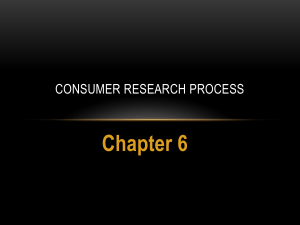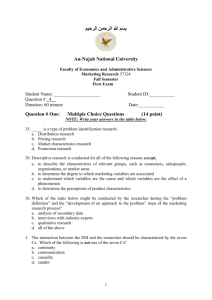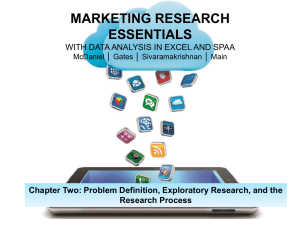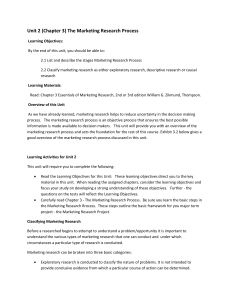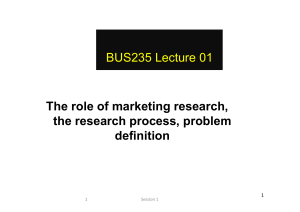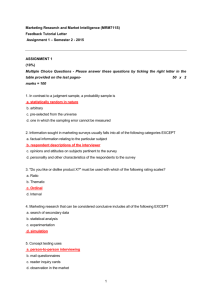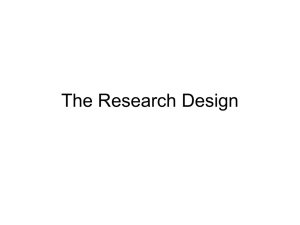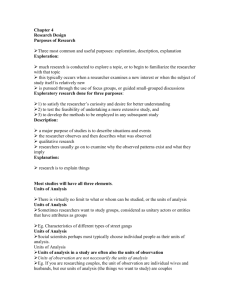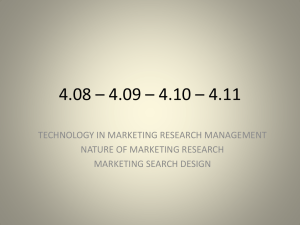Problem Definition and The Research Process
advertisement
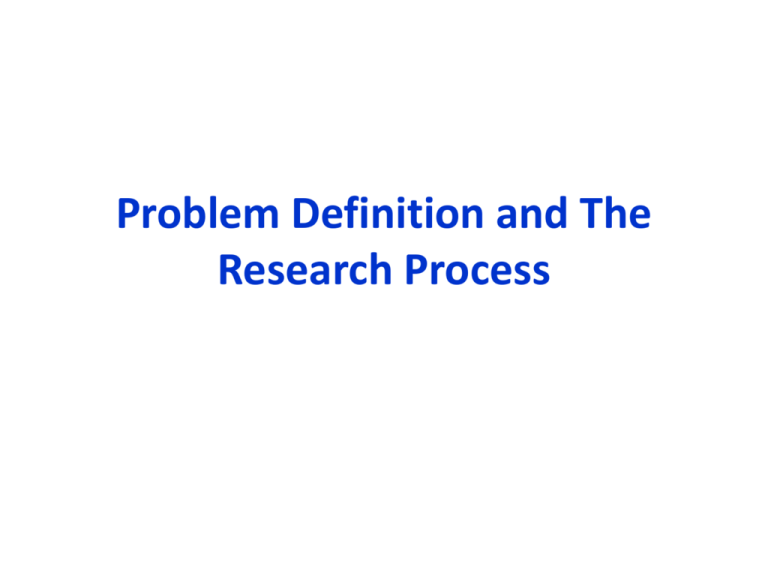
Problem Definition and The Research Process Critical Importance of Correctly Defining the Problem Recognize the problem or opportunity Find out why the information is being sought Understand the decision-making environment (the industry, company, products, and target market) Use the symptoms to help clarify the problem Translate the management problem into a marketing research problem Determine whether the information already exists Determine whether the question really can be answered State the research objectives Recognize the Problem/Opportunity • Changes occur in the firm’s external environment: – Should we change the existing marketing mix? – If so, How? • Marketing research may be used to evaluate the products and services, promotion, distribution, and pricing alternatives. • In addition it may be used to find and evaluate new opportunities, in the process called “opportunity identification” Example of Opportunity Identification • In 1990, there have been over 30 million babies born in the United States. They represent the largest generation since baby boomers. • Because of that increase in single-parent and dual earner households, kids are making shopping decisions once left to mom. • With their allowance, earnings, and gifts, children 14 and under will spend an estimated $20 billion a year, and they will influence another $200 billion in purchases. Example of Opportunity Identification • These statistics represent an opportunity. • Walt Disney, for example, launched a 24-hour kids’ radio network based on its marketing research. • General Motors did an analysis on backseat consumers that is children between 5-15 years. GM purchased the inside cover of Sports Illustrated for Kids (a mag. targeted to boys from 8-14 years) for the ad on the Chevy Venture minivan. Recognize Problem • Managers may want to know: – Why are we losing marketing share? – What should we do about our competitor lowering its prices by 10 percent? • In this instances, marketing researchers can help managers solve problems Find Out Why the Information Is Being Sought • Managers may not have a clear idea of what they want, therefore marketing researchers often find the following helpful: – Discuss what the info. will be used for and what decisions might be made as a result of the research. – Try to get the client/manager to prioritize their questions. – Create sample data and ask if such a data would help answer the questions. Simulate the decision process. Understand the Decision-Making Environment • The better the marketing researcher understands the decision-making environment, including the industry, the firm, its products or services, and the target market, the more likely it is that the problem will be defined correctly. • This step may be referred to as conducting a situation analysis. That is studying the decisionmaking environment within which the marketing research will take place. Understand the Decision-Making Environment • Sometimes informed discussions with managers and suppliers and on-site visits aren’t enough. • Exploratory research which is a preliminary research may be conducted to obtain greater understanding of a concept, to clarify the exact nature of the problem to be solved, or to identify important variables to be studied. It can take several forms: pilot studies, experience surveys, secondary data analysis, and case analysis. Exploratory Research • Pilot studies: surveys using a limited number of respondents and often employing less rigorous sampling techniques than are employed in large, quantitative studies. • Experience surveys: discussions with knowledgeable individuals, both inside and outside the organization, who may provide insights into the problem. (not with the formal questionnaire) • Case analysis: reviewing info. from situations that are similar to the current one. Use of the Symptoms to Clarify the Problem • A symptom is a phenomenon that occurs because of existence of something else. • Example: problem of poor sales, declining profits, increased customer complaints, or defecting customers. each of these is a symptom of a deeper problem. That is , something is causing a company’s customers to leave. Use of the Symptoms to Clarify the Problem • Focusing on symptoms and not the true problem is often referred to as the iceberg principle. • Approx. 10% of iceberg rises out of the ocean; the remaining 90% is below the surface. • Preoccupied with the obstacle they can see, managers may fail to comprehend and confront the deeper problem, which remain submerged. Iceberg Principle Translate the Management Problem into a Marketing Research Problem • Management decision problem: a statement specifying the type of managerial action required to solve the problem. • Once it has been identified, it must be converted into a marketing research problem. • The marketing research problem specifies what info. is needed to solve the problem and how that info. can be obtained efficiently and effectively. Determine Whether the Information Already Exists • Using existing data can save managers time and money if such data can answer the research question. Determine Whether the Question Can Be Answered • When marketing researchers promise more than they can deliver, they hurt the credibility of marketing research. • It is extremely important for the researchers to avoid being impelled into an effort that they know has a limited probability of success. State the Research Objectives • The climax of the problem definition is a statement of the research objectives. • These are stated in terms of the precise info. necessary to address the marketing research problem/opportunity. • Research objectives must be specific and unambiguous as possible. Marketing Research Process 1. Identification on the Problem and Statement of Research Objectives 4. Selection of the Sampling Procedure 2. Creation of the Research Design 3. Choice of Method of Research 5. Collection of the Data 8. Follow-up 6. Analysis of the Data 7. Writing and Presentation of the Report 2. Creating Research Design • Research design: the plan to be followed to answer the marketing research objectives. • There is no single best design. Instead, different designs offer array of choices, with certain advantages and disadvantages. • First, the researchers need to decide whether the research will be descriptive or causal. Descriptive and Causal Studies • Descriptive studies: research studies that answer the questions who, what, when, where, and how. It primarily describe what is going on/ what exists. • Implicit descriptive research is the fact that management already knows/understands the underlying relationships among the variables in the problem. – Variable: a symbol/concept that can assume any one of a set values. Descriptive and Causal Studies • Causal studies: research that examine whether the value of one variable causes or determines the value of another variable. – Dependent variable: a symbol/concept expected to be explained or influenced by independent variable. – Independent variable: a symbol/concept over which the researcher has some control and that is hypothesized to cause or influence the dependent variable. 3. Choosing a Basic Method of Research 1. Survey research: research in which an interviewer interacts with respondents to obtain facts, opinion, and attitudes. 2. Observation research: descriptive research that monitors respondents’ actions without direct interaction. 3. Experiment research: research to measure causality, in which the researcher changes one or more variables and observes the effect of the changes on another variable. 4. Selecting the Sampling Procedure • A sample is subset from a larger population. • Several questions must be answered before a sampling procedure is selected. 1. The population/universe of interest must be defined 2. Whether to use a probability sample or nonprobability sample (more details will be in the sampling topic) 5. Collecting Data • Interview-based data collection is done by marketing research field services. • To ensure that all subcontractors do everything exactly the same way, detailed field instructions should be developed to every job. 6. Analyzing the Data • The purpose of this analysis is to interpret and draw conclusions from mass of collected data. • The marketing researcher may use a variety of techniques for the analysis. 7. Writing and Presenting the Report • The researcher must prepare the report and communicate the conclusions and recommendations to management in both written and oral reports. • This is a key step in the process because a marketing researcher who wants project conclusions acted on must convince the manager that the results are credible and justified by the data collected. 8. Following Up • It is important that the research finding be used. • Management should determine whether the recommendations were followed and, if not, why not. MANAGING THE RESEARCH PROCESS Managing Research Process • The Research Request • Request for Proposal • What to Look for in a Marketing Research Supplier Managing Research Process The Research Request • An internal document used by large organizations that describes a potential research project, its benefits to the organization, and estimated costs; it must be formally approved before a research project can begin. The Research Request • The sections of a formal research request are as follows: – Action: actions to be taken on the basis of research – Origin: events led to a need for decision – Information: list the questions that needs to have answered to take action – Use: how each piece of info. will be used to help make the actual decision – Target groups and subgroups – Logistics: approximation of the available budget and time – Comments: other comments relevant to the research project Managing Research Process Request for Proposal (RFP) • A solicitation sent to marketing research suppliers inviting them to submit a formal proposal, including a bid. • A typical RFP provides background data on why a study is to be conducted, outlines the research objectives, describes a methodology, and suggests a time frame. • Most of RFPs also ask for (1) detailed cost breakdown, (2) the supplier’s experience in relevant area, and (3) references Managing Research Process What to Look for in a Marketing Research Supplier • Top 10 list of desirable qualities in marketing researchers: 1. 2. 3. 4. 5. 6. 7. 8. 9. 10. Maintains client confidentiality Is honest Is punctual Is flexible Delivers against project specifications Provides high-quality output Is responsive to the client’s needs Has high quality control standards Is customer-oriented in interactions with client Keeps the client informed throughout a project 1st Part of Group Project (10 out of 30 points) • Group of 6 members (8 groups) • Presentation on the selected topic • Start your presentation from next week (1 group/ class) 1. 2. 3. 4. 5. 6. 7. 8. Exploratory research and qualitative analysis (Tong) Digital research using secondary data (Kloster) Survey research (Eyes) Observation (Pim) Experimental research and test marketing (Jeerapa) Measurement (Phitpawee) Questionnaire design (May) Sampling: sample design and sample size (Zinn)
